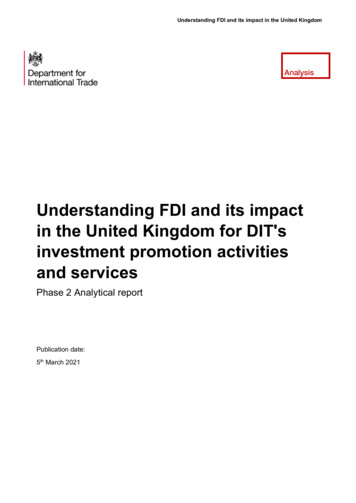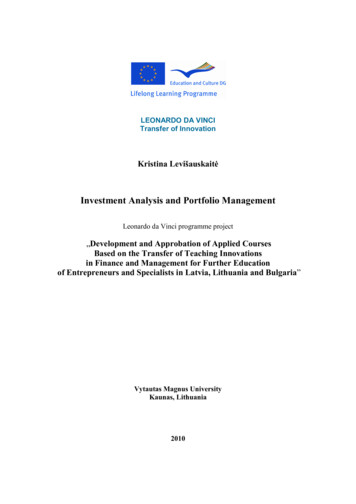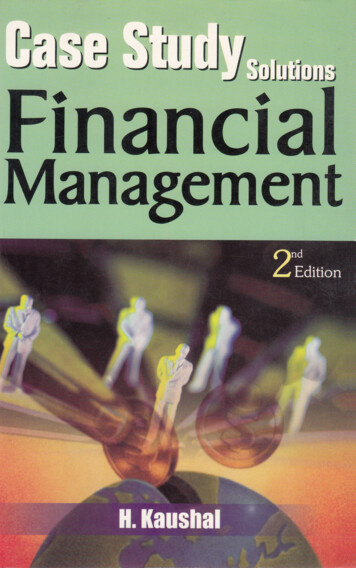
Transcription
Guide to investment strategyGuide Investment Strategy.indd 113/11/2013 10:54
other economist booksGuide to Analysing CompaniesGuide to Business ModellingGuide to Business PlanningGuide to Cash ManagementGuide to CommoditiesGuide to Decision MakingGuide to Economic IndicatorsGuide to Emerging MarketsGuide to the European UnionGuide to Financial ManagementGuide to Financial MarketsGuide to Hedge FundsGuide to Management Ideas and GurusGuide to Managing GrowthGuide to Organisation DesignGuide to Project ManagementGuide to Supply Chain ManagementNumbers GuideStyle GuideBook of Business QuotationsBook of IsmsBook of ObituariesBrands and BrandingBusiness ConsultingBusiness StrategyBuying Professional ServicesDoing Business in ChinaEconomicsManaging TalentManaging UncertaintyMarketingMarketing for GrowthMegachange – the world in 2050Modern Warfare, Intelligence and DeterrenceOrganisation CultureSuccessful Strategy ExecutionThe World of BusinessDirectors: an A–Z GuideEconomics: an A–Z GuideInvestment: an A–Z GuideNegotiation: an A–Z GuidePocket World in FiguresGuide Investment Strategy.indd 213/11/2013 10:54
Guide to investmentstrategyHow to understand markets, risk, rewardsand behaviourThird editionPeter StanyerGuide Investment Strategy.indd 313/11/2013 10:54
THE ECONOMIST IN ASSOCIATION WITHPROFILE BOOKS LTDPublished by Profile Books Ltd3a Exmouth HousePine StreetLondon ec1r 0jhwww.profilebooks.comCopyright The Economist Newspaper Ltd, 2006, 2010, 2014Text copyright Peter Stanyer, 2006, 2010, 2014All rights reserved. Without limiting the rights under copyright reserved above, no partof this publication may be reproduced, stored in or introduced into a retrieval system,or transmitted, in any form or by any means (electronic, mechanical, photocopying,recording or otherwise), without the prior written permission of both the copyrightowner and the publisher of this book.The greatest care has been taken in compiling this book. However, no responsibilitycan be accepted by the publishers or compilers for the accuracy of the informationpresented.Where opinion is expressed it is that of the author and does not necessarily coincidewith the editorial views of The Economist Newspaper.While every effort has been made to contact copyright-holders of material produced orcited in this book, in the case of those it has not been possible to contact successfully,the author and publishers will be glad to make amendments in further editions.Typeset in EcoType by MacGuru Ltdinfo@macguru.org.ukPrinted in Great Britain by Clays, Bungay, SuffolkA CIP catalogue record for this book is available from the British LibraryHardback isbn: 978 1 78125 071 6Paperback isbn: 978 1 78125 072 3e-book isbn: 978 1 84765 913 2The paper this book is printed on is certified by the 1996 Forest Stewardship Council A.C. (FSC).It is ancient-forest friendly. The printer holds FSC chain of custody SGS-COC-2061Guide Investment Strategy.indd 413/11/2013 10:54
To AlexGuide Investment Strategy.indd 513/11/2013 10:54
Guide Investment Strategy.indd 613/11/2013 10:54
ContentsList of figures xivList of tables xviiiAcknowledgements xxForeword xxiiiIntroduction xxvPart 1 The big picture1Setting the scene 3Think about risk before it hits you 3The Madoff fraud 5Betrayal aversion 10How much risk can you tolerate? 10Attitudes to risk and the financial crisis 13Know your niche 13War chests and umbrellas 16Base currency 162Understand your behaviour 18Insights from behavioural finance 18Investor biases 20Investor preferences 24Loss aversion 24The “fourfold pattern” of attitudes to gains and losses 25Mental accounting and behavioural portfolio theory 27Investment strategy and behavioural finance 28Guide Investment Strategy.indd 713/11/2013 10:54
Parameter uncertainty and behavioural finance Traditional finance, behavioural finance and evolution 33031Market investment returns 33Sources of investment performance 34Are government bonds risk-free? 35Sovereign risk and “a country called Europe” 37Safe havens that provide different kinds of shelter 38Which government bonds will perform best? 40Is the break-even inflation rate the market’s forecast? 43What premium return should bond investors expect? 48The place of safe-harbour government bonds in strategy 48The equity risk premium 49Equity risk: don’t bank on time diversifying risk 594 How should and how do investor strategies evolve? 64Model investment strategies 64Risk-taking and portfolio rebalancing 66The evolution of wealth and its investment since 2002 73What is a sovereign wealth fund? 75Liquid alternative investments 795The time horizon and the shape of strategy:keep it simple 81An appropriate role for strategy models 81Asset allocation models: an essential discipline 82Short-term investment strategies 83How safe is cash? 84No all-seasons short-term strategy 84Do bonds provide insurance for short-term investors? 85Are you in it for the long term? 88Time horizon for private and institutional wealth 88Long-term investors 90Financial planning and the time horizon 91“Safe havens”, benchmarking, risk-taking and long-termstrategies 92The danger of keeping things too simple 92Guide Investment Strategy.indd 813/11/2013 10:54
Declines in prices are sometimes good for you 93Unexpected inflation: yet again the party pooper 95“Keep-it-simple” long-term asset allocation models 95Should long-term investors hold more equities? 97Inflation, again 98Laddered government bonds: a useful safety-firstportfolio 99Bond ladders, tax and creditworthiness: the case of USmunicipal bonds 101Municipal bond ladders: the impact of the credit crisisand ultra-low interest rates 106What’s the catch in following a long-term strategy? 107Market timing: an unavoidable risk 108Some “keep-it-simple” concluding messages 110The chance of a bad outcome may be higher than you think 110“Models behaving badly” 115Part 2 Implementing more complicated strategies6 Setting the scene 121A health warning: liquidity risk 121Investing in illiquid markets 121“Liquidity budgets” 122Illiquidity in normally liquid markets 123Behavioural finance, market efficiency and arbitrageopportunities 125Barriers to arbitrage 126Fundamental risk and arbitrage 126Herd behaviour and arbitrage 127Implementation costs, market evolution and arbitrage 130Institutional wealth and private wealth: taxation 1317Equities 135The restless shape of the equity market 135Concentrated stock positions in private portfolios 135Guide Investment Strategy.indd 913/11/2013 10:54
Stockmarket anomalies and the fundamental insight of thecapital asset pricing model 137“Small cap” and “large cap” 140Will it cost me to invest ethically or sustainably? 143Don’t get carried away by your “style” 145Value and growth managers 147Should cautious investors overweight value stocks? 148Fashionable investment ideas: low volatility equity strategies 151Equity dividends and cautious investors 151Home bias: how much international? 152Who should hedge international equities? 159How much in emerging markets? 162Fashionable investment ideas: frontier markets 1678 Credit 169Credit quality and the role of credit-rating agencies 171Portfolio diversification and credit risk 179Local currency emerging-market debt 182Securitisation, modern ways to invest in bond markets andthe credit crunch 183Mortgage-backed securities 184The role of mortgage-backed securities in meetinginvestment objectives 186International bonds and currency hedging 189What does it achieve? 190What does it cost? 192How easy is foreign exchange forecasting? 1949 Hedge funds 195What are hedge funds? 197Alternative sources of systematic return and risk 198“Do hedge funds hedge?” 199The quality of hedge fund performance data 201What motivates hedge fund managers? 202Are hedge fund fees too high? 203The importance of skill in hedge fund returns 204Guide Investment Strategy.indd 1013/11/2013 10:54
The shape of the hedge fund market 205Hedge fund replication and “alternative betas” 207Directional strategies 209Global macro 209Equity hedge, equity long/short and equity marketneutral 209Short-selling or short-biased managers 211Long-only equity hedge funds 211Emerging-market hedge funds 212Fixed-income hedge funds: distressed debt 213Arbitrage strategies 214Fixed-income arbitrage 214Merger arbitrage 215Convertible arbitrage 216Statistical arbitrage 216Multi-strategy funds 217Commodity trading advisers (or managed futures funds) 218Hedge fund risk 220Madoff, hedge fund due diligence and regulation 220Operational risks 220Illiquid hedge fund investments and long notice periods 221Lies, damn lies and some hedge fund risk statistics 222“Perfect storms” and hedge fund risk 224Managing investor risk: the role of funds of hedge funds 225How much should you allocate to hedge funds? 226Questions to ask 228Your hedge fund manager 228Your hedge fund adviser 233Your fund of hedge funds manager 23310 Private equity: information-based investment returns 234What is private equity? 235Private equity market risk 236Listed private equity 240Private equity portfolios 243Private equity returns 243Guide Investment Strategy.indd 1113/11/2013 10:54
Private investments, successful transactions and biasesin appraisal valuations 24611 Real estate 248What is real estate investing? 249What are the attractions of investing in real estate? 251Diversification 251Modern real estate indices and assessing the diversifyingrole of real estate 251Income yield 258Inflation hedge 259Styles of real estate investing and opportunities for activemanagement 259What is a property worth and how much return shouldyou expect? 260Rental income 260Government bond yields as the benchmark for realestate investing 263Tenant credit risk 263Property obsolescence 264Private and public markets for real estate 264International diversification of real estate investment 266Currency risk and international real estate investing 26612 Art and investments of passion 268How monetary easing probably inflated the pricesof fine art and collectibles 269Psychic returns from art and collectibles 270Wealth, inequality and the price of art 273Art market indices 278Price indices for other investments of passion or“collectibles” 280Investing in art and collectibles 284Shared characteristics of fine art and other investments ofpassion 287Guide Investment Strategy.indd 1213/11/2013 10:54
Appendices1 Glossary 2 Essential management information for investors 3 Trusting and aligning with your adviser 4 Sources and recommended reading 289304311315 Notes on sources 331Index 334Guide Investment Strategy.indd 1313/11/2013 10:54
List of figures1.1 If it looks too good to be true, it probably is 71.2 Risk tolerance scores and equity market returns 113.1 Income yield from 10-year US Treasury notes and3-month Treasury bills 383.2 Income yield from 10-year UK gilts and 6-monthTreasury bills 393.3 Income yield from 10-year euro-zone AAA Treasurybonds and 3-month Treasury bills 393.4 US Treasury conventional and real yield curves 413.5 UK Treasury conventional and real yield curves 413.6 Euro-zone AAA rated Treasury conventional yield curve 423.7 US Treasury 20-year yields 443.8 US 20-year “break-even” inflation (difference between20-year Treasury and TIPS yields) 443.9 UK 20-year gilt yields 453.10 UK 20-year “break-even” inflation 453.11 US cash, government bonds and stockmarket cumulativeperformance 513.12 UK cash, government bonds and stockmarket cumulativeperformance 513.13 Cumulative performance of equities relative to long-datedgovernment bonds 533.14 There are no free lunches: cumulative performance ofequities relative to long-dated government bonds inleading markets 543.15 20-year equity risk premium over Treasury bills 543.16 20-year equity risk premium over government bonds 55Guide Investment Strategy.indd 1413/11/2013 10:54
List of figures xv3.17 Frequency of equity outperformance of bonds,overlapping 5-year periods 623.18 Frequency of equity outperformance of bonds,overlapping 20-year periods 624.1 VIX indicator of US stockmarket volatility 664.2 Tobin’s Q: ratio of the market value of US corporateequity to replacement cost 684.3 S&P 500 “Shiller” price/earnings ratio 694.4 Spread between single A credit indices and highest-ratedgovernment bond indices 704.5 US Treasury 10-year constant maturity yields 725.1 Stylised surplus risk and opportunity for long-terminvestors, stylised approach 975.2 Comparison of municipal and US Treasury long-datedbond yields 1045.3 Long-dated municipal bond yields as a percentage of USTreasury yields 1045.4 US stocks, bonds and cash: “efficient frontier” and modelallocations for “short-term” investors 1147.1 Cumulative total return of US small cap and large capstocks 1417.2 10-year rolling average returns for US small cap and largecap stocks 1427.3 Ethical investing, cumulative returns 1447.4 Cumulative total return performance of US growth andvalue equity indices 1497.5 Volatility of US growth and value equity indices, 36-monthrolling standard deviations of return 1497.6 US value and growth equity indices, 5-year rollingperformance 1507.7 US and international equities, 5-year rolling equityperformance 1547.8 UK and international equities, 5-year rolling performance 1547.9 Volatility of domestic and global equities from alternativenational perspectives 155Guide Investment Strategy.indd 1513/11/2013 10:54
xvi Guide to investment strategy7.10 Who needs international equity diversification?Volatility of equity investments from a US, Chinese andIndian perspective 1577.11 Correlations between US equity market, internationalequities and emerging-market equities 1587.12 Correlations between UK equity market, internationalequities and emerging-market equities 1587.13 International equity volatility from the perspective ofdifferent countries, annualised standard deviationof returns 1607.14 US perspective on impact of hedging internationalequities, 36-month rolling standard deviation of returns 1607.15 UK perspective on impact of hedging internationalequities, 36-month rolling standard deviation of returns 1617.16 Volatility of world and emerging-markets equities, 5-yearrolling annualised standard deviations of returns 1637.17 Performance of emerging-market equities in best upmonths for world equities 1637.18 Performance of emerging-market equities in worst downmonths for world equities 1647.19 5-year rolling beta between emerging-market and worldequities 1657.20 10-year rolling returns from developed andemerging-market equities 1657.21 World, emerging and frontier markets, 36-month rollingcorrelations 1678.1 Default rate of Fitch-rated issuers of corporate bonds 1748.2 US corporate bond spreads 1768.3 Cumulative performance of US under 10-year Treasuryand corporate bonds 1778.4 Yields on US mortgage securities 1858.5 Cumulative performance of agency mortgage-backedsecurities and commercial mortgages 1858.6 US government bond monthly returns compared withmortgage-backed securities 1878.7 German government bond performance in euros 1908.8 German government bond performance in US , unhedged 191Guide Investment Strategy.indd 1613/11/2013 10:54
List of figures 411.511.611.712.112.212.312.412.5German government bond performance hedged to US 191Hedge fund industry assets under management 196Cumulative performance of hedge fund index and equities 200Hedge fund assets under management by type of strategy 206Monthly performance of arbitrage and multi-strategyhedge fund indices 225Volatility of public and private equity, proxied by 3i shareprice and FTSE 100 index 237Volatility of private and public equity, proxied by 60-dayvolatility of 3i relative to UK stockmarket 237Volatility of total equity as private equity increases 240Cumulative performance of global listed private equitycompanies and global equities 242The four quadrants of real estate investing 250Valuation-based and transaction-based measures of totalreturn from real estate investments in the US 253Valuation-based and transaction-linked measures ofcommercial real estate prices in the UK 253Valuation-based and transaction-linked measures ofcommercial real estate prices in the euro zone 254Cumulative performance of US equities and REITs 255Volatility of US equity REITs and US stockmarket, rolling36-month standard deviations of return 256Is it cheaper to buy real estate on Wall Street or Main Street?US REITs’ share price compared with Green Streetestimates of property net asset value 265Returns from fine art, stamps, violins, gold and financialassets 272Worldwide fine art auction house sales 275Calendar year performance of global equities and classiccars 283Monthly performance of world equities and classic cars 283British Rail Pension Fund realised rates of return for 2,505individual works of art acquired between 1974 and 1980 286Guide Investment Strategy.indd 1713/11/2013 10:54
List of tables3.1 Long-run market performance and risk 523.2 Longest periods ending December 2012 of equitiesunderperforming long-dated government bonds 563.3 Does time diversify away the risk of disappointing equitymarket performance? 614.1 Indicators of global investable assets 744.2 Pattern of asset allocation by global investors 765.1 Unaggressive strategy: negative return risk varies asinterest rates move 855.2 Bond diversification in months of equity market crisis 865.3 Bond diversification in years of extreme equity marketperformance 875.4 Stylised model long-term strategies, with only stocks,bonds and cash 965.5 Model short-term investment strategies, with only stocks,bonds and cash: historical perspective 1125.6 Model short-term investment strategies, with only stocks,bonds and cash: forward-looking perspective 1135.7 US and global capital markets: volatility and excesskurtosis 1166.1 The impact of taxation on taxable investment returns andwealth accumulation 1338.1 Government bond and equity markets 1708.2 Long-term rating bands of leading credit-rating agencies 1728.3 Corporate bond average cumulative default rates 1738.4 US corporate bond yields, spreads and performance 1758.5 US investment grade credit spreads and excess returns 178Guide Investment Strategy.indd 1813/11/2013 10:54
List of tables xix8.6 Performance of selected debt markets in months ofextreme US equity performance 8.7 US corporate high-yield and emerging debt marketssummary statistics 8.8 Performance and volatility of components of Barclays USAggregate bond index 9.1 Hedge fund performance during calendar quarters ofequity market crisis 9.2 Hedge fund industry: assets under management 9.3 Hedge fund performance during calendar quarters ofequity market crisis 9.4 Selected hedge fund strategies: correlations withglobal equity market 9.5 Equity hedge fund performance during calendar quartersof equity market crisis 9.6 Emerging-market hedge fund performance duringcalendar quarters of equity market crisis 9.7 Fixed-income hedge fund performance during calendarquarters of equity market crisis 9.8 Arbitrage hedge fund performance during calendarquarters of global equity market weakness 9.9 Multi-strategy hedge fund performance during calendarquarters of equity market crisis 9.10 Managed futures fund (CTA) and commodity indexperformance during calendar quarters of equity market crisis 10.1 Geographical spread of Standard & Poor’s Listed PrivateEquity index 11.1 Direct real estate investment by type of property 11.2 US, UK and euro zone real estate market indices: volatility,and correlations with stocks and bonds 11.3 Income yield from REITs, quoted equities and bonds 11.4 Direct real estate investment by type of property Guide Investment Strategy.indd 25826113/11/2013 10:54
AcknowledgementsI owe a debt of gratitude to many individuals who helped mewith this book. First and foremost to my wife, Alex, for her continuedsupport and patience through this edition’s labour. Elroy Dimsonand Steve Satchell provided invaluable advice and suggestions(as for the previous editions). Stephen Collins provided importantadvice, suggestions and introductions. Colleagues at Delmore AssetManagement and the Financial Planning Corporation have beenparticularly patient as I have been preoccupied with the book. Manyformer colleagues have also been generous with their suggestions. Ialso owe a substantial debt to the trustees and principals of the fundsthat I have been privileged to work with over the years.I have been privileged to attend a number of seminars organisedby Norway’s Government Pension Fund (Global) in the past fewyears. This book has benefited considerably from the insights gainedat these world-class meetings, which debate the interface betweenacademic research and practical investment issues.Generous and insightful contributions on particular issues orchapters were provided by Victoria Barbary, Paul Barrett, Jörg Behrens,Nick Bucknell, Jeff Bryan, Ewen Cameron-Watt, Forrest Capie, NormanDeitrich, Robin Duthy, Hugh Ferry, Geoffrey Fiszel, Charlie Goldring,Howard Goldring, Dietrich Hatlapa, Arzu Huseynov, Tim Lund, YoramLustig, Cesar Murillo, Arlen Oransky, Steve Piercy, Mark Ralphs, JohnPullar-Strecker, Max Rayner, Christof Schmidhuber, Paul Stanyer andJames Wyatt. I am most grateful to each of them, but any mistakesare my own.I am also indebted to those firms whose data I have used in thenumerous tables and charts. Without their support the book could notGuide Investment Strategy.indd 2013/11/2013 10:54
Acknowledgements xxibe published in this form. I would also like to thank Stephen Broughat Profile Books for his encouragement, suggestions and support. Mythanks are also due to Penny Williams, who skilfully and patientlyedited the book.This book aims to help inform the process of seeking and givingprofessional advice, but it cannot be a substitute for that advice. Itdraws on and summarises research and investor perspectives on awide range of issues, but it is not punctuated with footnotes citingsources for facts or opinions. Although important areas of debate areflagged with references to leading researchers, in other areas ideaswhich are more commonly expressed are presented but not attributed.Sources which were particularly important for each chapter are listedin Appendix 4.Please note that the views expressed in this book are my own andmay not coincide with the views of the investment funds on whoseboards or committees I am honoured to serve.In conclusion, let me say how privileged I am that Elroy Dimson,Emeritus Professor of Finance at London Business School, has agreedto write a foreword for this third edition of the book. Although myappreciation of markets owes a great deal to the economics that Ilearnt at Cambridge University, particularly from the late MichaelPosner and from Michael Kuczynski at Pembroke College, the LondonBusiness School’s Investment Management Programme gave me aninvaluable bridge from economics to modern finance.Guide Investment Strategy.indd 2113/11/2013 10:54
Guide Investment Strategy.indd 2213/11/2013 10:54
ForewordInterest rates have collapsed. Savers who put aside moneynow, to spend in the future, will earn little by way of interest. Toaccumulate a target lump sum, they need to save more than theyonce planned. Retirees, who wish to live on their savings, can nowexpect to receive a smaller income from their investments. They mustadjust to having less to spend than they expected.Of course, low interest rates and low bond yields were for sometime clear for all to see. It was less obvious that low interest ratesimply low prospective returns on all assets, including equities.Because investors require some compensation for the higher risk ofthe stockmarket, equity returns must be equal to the interest rate plusa “risk premium”. It follows that, other things being equal, a worldwith low interest rates must also be a world in which stockmarketinvestors receive lower returns.What are the implications of this dramatic change in the financialenvironment? Peter Stanyer’s response is that every saver needs acoherent investment strategy. Strategy must be underpinned by anunderstanding of how markets move, how risk should be judged,how markets reward investors and how investors behave. In this thirdedition of his outstanding book, Peter Stanyer addresses these issuesand elegantly surveys the entire field of investment.He helps us to formulate an investment strategy that is realistic.The projections made by many asset managers, retail financial productproviders, pension funds, endowments, regulators and governmentsare optimistic. Overly optimistic estimates of future returns aredangerous, not only because they mislead, but also because they canmask the need for action.Guide Investment Strategy.indd 2313/11/2013 10:54
xxiv Guide to investment strategyInvestors vary in their need for liquidity, their tolerance forrisk, and their capacity to follow a disciplined investment strategy.They therefore need to devise a strategy that reflects their salientcharacteristics. The strategy should be founded on three pillars. Thefirst pillar is financial theory – how financial markets can be expectedto behave; the second is empirical evidence – how markets actuallydo behave; and the third is the investment environment – the currentcondition of financial markets.Peter Stanyer reviews the relevant aspects of financial theory in ahighly accessible way. He extends our knowledge without resorting tocomplicated mathematics, explaining the central concepts of modernfinance in a clear exposition of the arguments for and against differentapproaches. To better understand markets, he turns to the evidence offinancial history, often interrogating the long-term, global dataset thatmy colleagues and I have compiled. He allows the record of securitiesmarkets to enlighten us about events in the past and to underpininformed judgments about the future.To interpret the current investment environment, Peter Stanyerpresents us with a wealth of data. Drawing together theory, evidenceand information on the financial environment, he does not flinchfrom expressing a firm opinion. He presents valuable advice on howto construct a fixed-income portfolio, how to think about liquidity,what quantum of risk is acceptable for different investors, whatfactors influence investment performance, whether investments ofpassion are a store of value, and what behavioural biases investorsshould guard against.There is something for everyone in this book. It is comprehensive,but never forbidding or opaque. The surveys of each of the main assetclasses – equities and risky debt, alternative assets like hedge fundsand private equity, and tangible assets like real estate and artworks– are highly informative and the complexities of modern investingare explained with great clarity. This book will help you meet thechallenge of investing for your future.Elroy DimsonDecember 2013Guide Investment Strategy.indd 2413/11/2013 10:54
Introduction: lessons from theglobal financial crisisThe years since the credit crisis of 2007–9 have seen anumber of refreshingly simple investment messages gain tractionthat should enable investors to weather future storms in bettershape. These messages are as relevant to individuals managing theirown retirement savings as to the managers of the largest investmentfunds.One, emphasised by Antti Ilmanen, is that the timing of investmentvolatility matters as much as its magnitude. Andrew Ang stresses thisby asserting that the two most important words in investing are “badtimes”. This is a theme running through this edition and it has severalaspects. One is that past performance patterns can easily give a falselyreassuring impression of the likelihood of “bad times”. Another isthat investors should initiate discussions about how an investmentproposal might perform in bad times. If the investment will helpmitigate losses of income or capital and give flexibility in bad times, itwill be an attractive investment; if it might amplify them, and imposeinflexibility, investors will need to be rewarded amply for that and tounderstand why the reward is expected to be sufficient, given theircircumstances. This applies with particular force to the costs imposedby illiquid investments.Almost all investment products offer an alluring combination ofrisk and return. When these offer a better prospect than normallyoffered by the market, investors should always ask, how? Betterthan market performance must reflect some combination of rareskill; exploiting a market anomaly (but see Chapter 6); or a rewardfor risk-taking (see Chapter 7). The victims of the Madoff fraudsuffered because they or their advisers accepted the description ofGuide Investment Strategy.indd 2513/11/2013 10:54
xxvi Guide to investment strategypast apparent good performance with low volatility of his fraudulentfunds as descriptions of how they did, and so would, perform. Thevictims’ suffering was all the worse because their trust was betrayedby Madoff (see Chapter 1).All investors need to ask for explanations of attractive performance.Low volatility strategies in equities and credit are always popular,and Chapters 7 and 8 encourage investors to suspect that obscurerisk-taking may be the explanation. If it is, investors are forewarnedthat the attractive risk-return trade-off, which is a characteristic ofnormal times, might provide little protection in “bad times”. This wasa message of John Campbell and Tuomo Vuolteenaho’s (2004) article“Bad Beta, Good Beta” (see Chapter 7). It is also the message that hedgefunds and private equity are risk assets, and a usually reliable shortcut is to see them as types of equity investing. They will probably notprovide much help in “bad times”, but might nevertheless provideinteresting opportunities (Chapters 9 and 10).After 2008, some complained that the poor diversificatio
Guide to investment strateGy How to understand markets, risk, rewards and behaviour Third edition Peter










